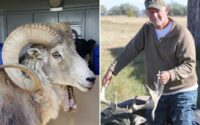Bear who escaped St. Louis Zoo enclosure twice moving to new park with moat
A New York City-born bear who escaped from his enclosure at the St. Louis Zoo twice last month is being moved to a facility in Texas — where he will be surrounded by a moat, officials announced.
Ben, a 4-year-old Andean bear, made national headlines after the escape artist broke out of his outdoor habitat two times in February.
On Tuesday, St. Louis Zoo officials announced that after considering Ben’s “specific and unique personality, the 280-pound bear will be moved to the Gladys Porter Zoo in Brownsville, Texas.
There, his new enclosure will be surrounded by a moat as opposed to a steel mesh outdoor habitat that proved ineffective at keeping the bruin locked up.
“We looked at all options,” Regina Mossotti, the St. Louis Zoo’s vice president of animal care, told the St. Louis Post-Dispatch on Tuesday.
“We love Ben. He’s such a character, the team that has taken care of him has fallen in love with him. He’s so fun, he’s so playful — we would love to be able to keep him here.”


Ben, born at the Queens Zoo and shipped to St. Louis in 2021, made his first escape on Feb. 7 from the River’s Edge “immersion exhibit” after forcing his way through the steel mesh “in just the right spot,” officials said. He was captured about 40 minutes later before the zoo opened for the day.
Afterward, zoo employees “made the habitat even more secure by adding stainless steel cargo clips rated at 450 pounds tensile strength.”
But Ben busted out again on Feb. 24 when he crawled through a hole in the mesh fencing where it’s attached to support.
The escape sent visitors into a panic as they scrambled to safety in “various indoor facilities” as workers scoured the grounds to find the runaway around 1 p.m., the zoo said.


About 50 minutes later, Ben was spotted about 100 feet from the enclosure and shot with a tranquilizer dart, according to reports.
After his second breakout, St. Louis Zoo director Michael Macek said Ben would not be put back in the habitat until the zoo was “absolutely sure” he would not be able to get out again.
The Andean bear enclosure was built in 2014 and met all species standards. Staffers cared for Andean bears in the past with no escapees, the zoo said.
Ben is currently living in an indoor and outdoor facility in a non-public area of the St. Louis zoo where he is undergoing “positive reinforcement training” so his journey south in a travel crate goes smoothly, the zoo said Tuesday.


Walter Dupree, the curator of mammals at the Gladys Porter Zoo, told the Post-Dispatch the zoo is ready for Ben’s arrival.
“We’re confident it’s going to be good for Ben. It’s proved itself over the years,” Dupree said of the habitat.
He said the moat, about 8 feet deep, is in the front of the exhibit. Additional electrical wire is being added to the top of the 16-foot wall along the boat that would give Ben a mild shock if he climbed up.
“We’re not putting it anywhere he can get to it unless he pushes,” said Dupree.

Andean bears are also known as spectacled bears because of unique, individualized markings on their faces that can resemble eyeglasses. They’re the only bear species native to South America and live in the mountain forests that stretch from Bolivia to Venezuela.
They’re listed as “vulnerable” by the International Union for Conservation of Nature in Gland, Switzerland, with a decreasing population of just 2,500 to 10,000 mature animals left in the wild.


